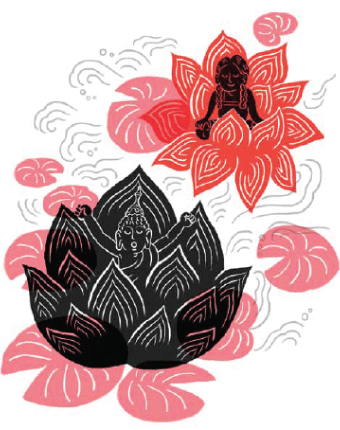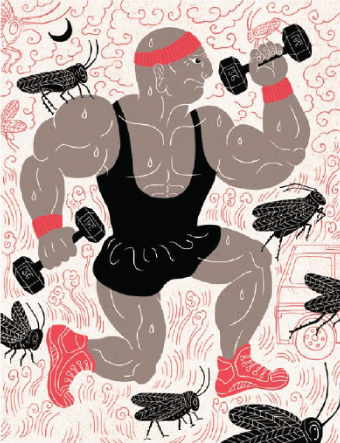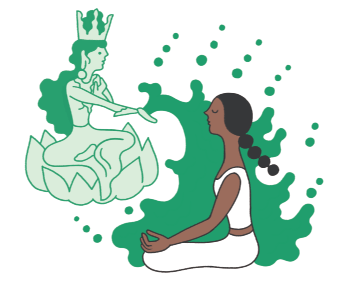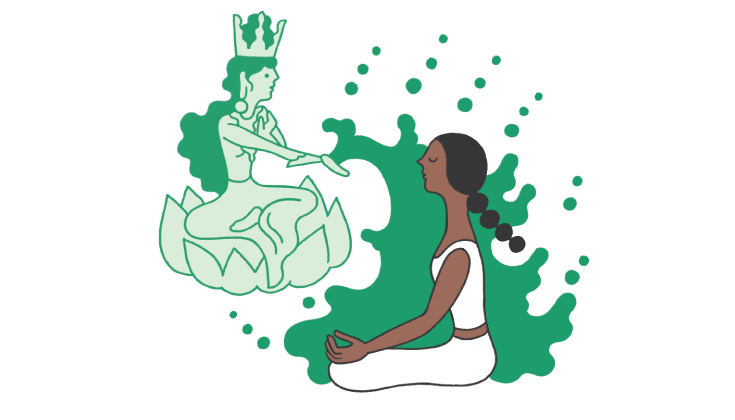Tomi Um’s first assignment as an editorial illustrator was for Lion’s Roar, back in January 2009 (when it was still known as Shambhala Sun.) The next year, Print magazine and Art Directors Club both named Um as one of the best new visual artists.
Since then, she’s illustrated for TIME, Popular Mechanics, the Wall Street Journal and the New York Times. Um’s artwork is now a regular feature in Lion’s Roar, having appeared in our “How To Practice” department nearly every issue.
Above are nine Lion’s Roar illustrations by Um, showcasing her blend of traditional inspiration, modern technique, and personal style (which she describes as “Bustling, bubbly, and good-time”). Here, Um talks about how Buddhism came into her artwork, and how her artwork came to us.
Why are you drawn to Buddhist artwork?

My interest in Buddhist art comes from my childhood in South Korea. Every summer I visited my Buddhist grandparents and visited the temples with them. Buddhist temples in Korea are located on the mountains surrounded by tranquil pine tree forest. Having been raised a city kid, hiking on the mountain trail to reach the temples was always an exciting adventure. I loved the smell of incense in the cold air when we reached the temple. Inside the temple, shiny-golden Buddha statues looked so life-like. I had awe and fear for them, and the Buddhist paintings that showed hellish places where guards stood over suffering people.
I’ve since moved to the US, and have little memory left of my life in Korea. However, Buddhist art evoke feelings of nostalgia for my childhood.
You’ve said you really like Operas, German expressionism, and architectural reference books. How do your diverse inspirations come together to form your often simple, always impactful illustrations?
When I am reading books, watching operas, or viewing an art exhibition, I just completely absorb and enjoy them. I can’t predict what happens to what I have absorbed and how the influence will show in my work. Maybe it comes out as something reminiscent of the original influence, or maybe it comes out as something completely transformed.
Lion’s Roar/Shambhala Sun was your first assignment. Can you tell me about that?

In the summer of 2008 I made a four-volume set of illustrated silkscreened books titled The Feast. They were fold-out books that open up as posters. They were wordless, but through illustrations the series told stories of monks’ lives around their favorite dish, noodles (See Vols 1, 2, 3 and 4). At the time, I wanted to get editorial illustration assignments from magazines and went to a bookstore in search of magazines that use illustrations. I picked out two Buddhist magazines, Shambhala Sun and Buddhadharma, to send copies of The Feast. Because my illustrations had many Buddhist motifs and elements, it felt like a good match. Soon I heard back from Liza Matthews, your art director, with an assignment to make a spread, a full-page, and a spot illustration for an article titled “The Green Path.”
What was the path of your career after that?
I got the taste of being an illustrator and I loved it, but realized it would take some time to get a constant flow of work to make a living. Soon I began working as textile designer during the day and continued doing illustration assignments for nights and weekends. A few years later, I was getting enough work enabling me to work full-time as an illustrator and haven’t stopped since.
What inspirations and thoughts came into play in your Green Tara illustrations in our March 2015 issue? Can you tell me a bit about the process of creating those illustrations?

This assignment is part of an ongoing series on How To Practice (found in Lion’s Roar‘s front section, “The Moment”). Each issue introduces a meditative practice along with a step-by-step instruction. Associate art director Andrew Glencross worked with me on this.
First, Andrew sent me detailed description of Tara and the breakdown of Tara meditation positions in stages, page layouts, the article, and reference images. Following Andrew’s art direction I made rough sketches of how the illustrations would sit on the pages. The art director and editor reviewed the sketches to see whether corrections or adjustments were needed. Once the sketches were approved, the next step was to move on to the final illustration.

